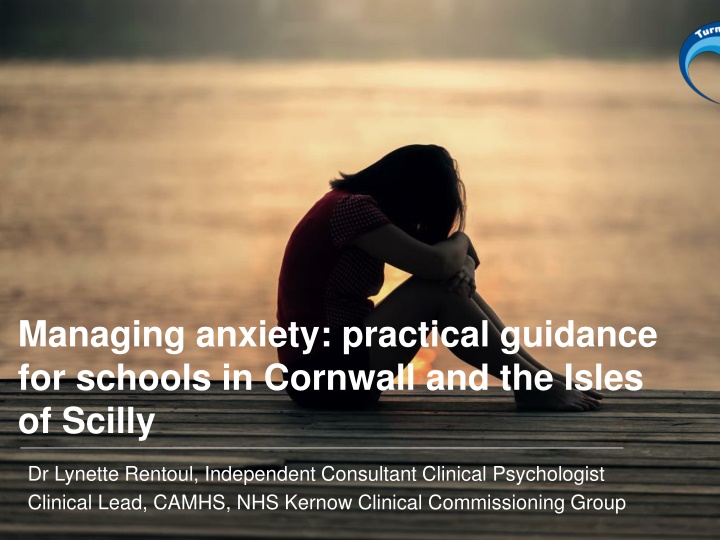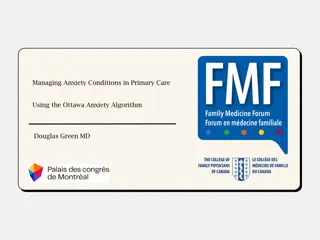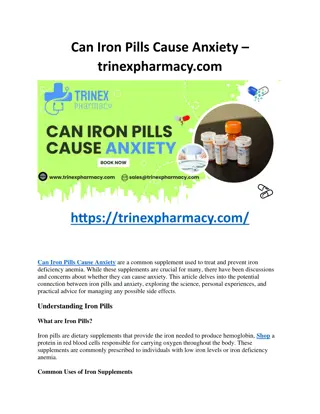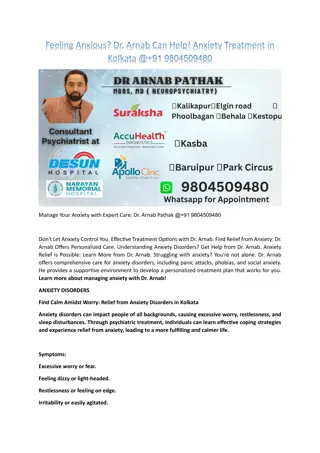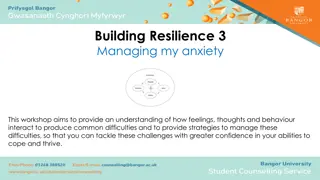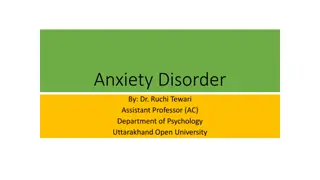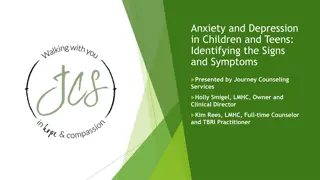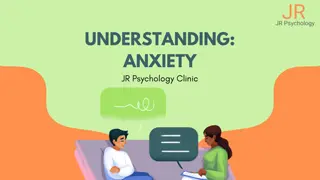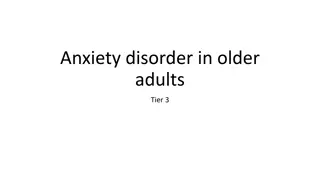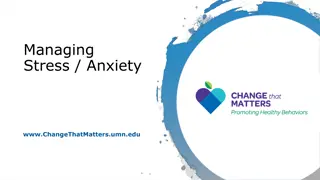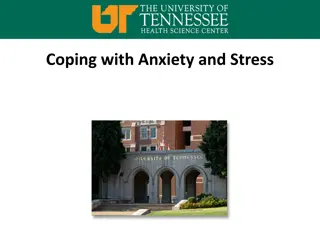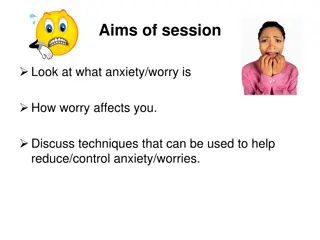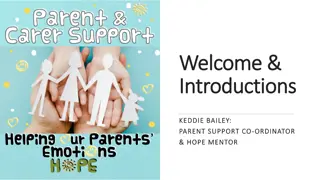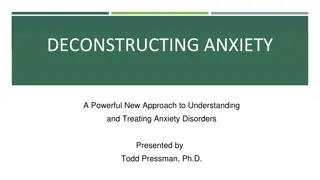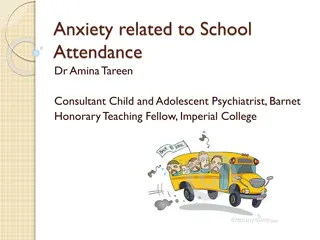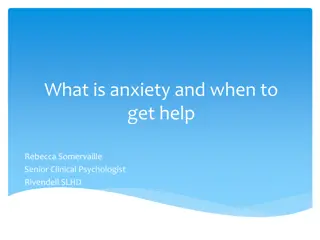Practical Guidance for Managing Anxiety in Schools
Anxiety is a normal human feeling that can become overwhelming for children, affecting their behavior and interactions. Understanding the roots of anxiety and its manifestations in children can help schools provide effective support to manage anxiety-related challenges.
Download Presentation

Please find below an Image/Link to download the presentation.
The content on the website is provided AS IS for your information and personal use only. It may not be sold, licensed, or shared on other websites without obtaining consent from the author.If you encounter any issues during the download, it is possible that the publisher has removed the file from their server.
You are allowed to download the files provided on this website for personal or commercial use, subject to the condition that they are used lawfully. All files are the property of their respective owners.
The content on the website is provided AS IS for your information and personal use only. It may not be sold, licensed, or shared on other websites without obtaining consent from the author.
E N D
Presentation Transcript
Managing anxiety: practical guidance for schools in Cornwall and the Isles of Scilly Dr Lynette Rentoul, Independent Consultant Clinical Psychologist Clinical Lead, CAMHS, NHS Kernow Clinical Commissioning Group
Understanding the nature of anxiety Anxiety is a normal, human feeling of fear, apprehension or panic a sense that something fearful or even disastrous may happen. It can be part of a helpful warning system, when there is danger. It occurs when we don t feel safe. When we face scary situations, the brain s built in alarm system warns us that something isn t right. It makes us feel more alert, stops us thinking about other things (can t learn) and sets off the alarm (arousal) system to prepare us for action or get help. Affects body, thinking and feelings. Arousal responses: Flight; Flight ore Freeze Most of us worry at times about friendships, parents, health, school pressures, natural disasters, news items, but usually worries go away, because we are helped or cope. Sometimes worries don t go away, Fears take over our minds and affect all aspects of life - anxiety itself becomes a problem, and needs special help to sort out. Child may end up feeling anxious all the time, and no longer know exactly what they fear simply preoccupied with their fears. Anxiety becomes a problem.
Understanding the early roots of anxiety: the foundations in neuroscience During the early years, we are dependent on adults to understand & attend to our needs in trusted & consistent ways, -keep us calm & safe. Young children experience strong emotions and require carers to think for them & sooth and calm them when anxious; contain their anxiety. Soothing a distressed child supports emotion regulation and is vital so that immature brains are not overwhelmed by anxiety (toxic stress). Responsive parenting soothes & regulates child s anxiety, they feel safe and free to explore and play; secure base & secure attachment . Separation or unresponsive/unpredictable/unsafe responses cause great anxiety, which the child can t regulate child feels unsafe & anxious. Children need trusted adults to support feelings of safety & security. The world can feel scary to children, so adults need to reassure them; help them problem solve when they feel overwhelmed to feel safe again.
Anxiety may underpin many behaviours that challenge at home and school Facing adversity provokes anxiety, to which children adapt; these adaptations (defences) may themselves cause problems (child sees them as helpful strategies), and not work in safe settings. Child becomes more vulnerable to impact of everyday pressures. Some children become angry, demanding or controlling because of their fears (Fight) to make things happen in predictable ways; to avoid feelings of shame; to ensure they are seen (if they fear they are invisible); their ways of managing unpredictable adults; experience dysregulation (Ambivalent attachment strategies). Some children fear criticism; judgment; punishment; getting things wrong; they are wary of others, & so avoid contact, and may seem rather cut off, isolated, lack social confidence (Flight). May find learning shaming, fear getting things wrong (Avoidant attachment).
Common childhood fears Common childhood fears are linked to our evolutionary past; include fears of heights; darkness; getting lost or separated from carers; some animals; storms. These usually pass with time, and plenty of reassurance/ calming. Little ones fear separation, getting lost, being alone, the dark, which often get worse at bedtime, or facing of new challenges or threats. Some children fear things they have read about or seen on films ghosts; kidnappers; dangerous adults; monsters. These fears are not uncommon and with support and reassurance pass with time. Older children/YP worry more about friendships; bullying; self image and body image; intimate relationships; sexuality; leaving home; adult responsibilities; academic work; finding work and purpose. Anxiety becomes a problem if these fears are severe and interfere with everyday functioning and activities, and don t pass with time.
The signs of anxiety: physical, thoughts and feelings Feeling nervous, on edge, panicky, clingy a lot of the time Feeling something bad is going to happen; feeling full of dread Feeling out of control; finding it hard to concentrate, learn or play Having trouble sleeping; being worried about bedtime; nightmares Losing appetite; wanting to eat more for comfort; tummy aches. Feeling tired, grumpy and edgy; increased distress; temper outbursts Physical feelings, like butterfly tummy , heart beating faster, dry mouth, trembling, feeling faint, sweating more than usual; fidgety. Feeling afraid of things that were previously enjoyed, such as afraid of separation from parents; afraid of going to school; or of going out with friends; not wanting to go out to clubs and leisure activities Wanting to stay at home/school, because that place that feels safe.
Anxiety across age ranges Children (5-11) more aware of dangers (news; adults talking; family conflict; illness; death); greater imagination to imagine the worst. Difficulties in mixing with children, v shy/timid. Negative thoughts; irritable, demanding, butterfly tummy . Constantly checking things OK seek reassurance; constantly fearful. Young children (0-5) may become clingy, fretful, irritable, & may regress in their behaviour (outbursts of distress); want to stay with parents at bedtime; may have frequent bad dreams; may wet the bed again. Common fears more pronounced. Young people (16-25) challenges increased separation from family; exam pressures; greater responsibilities; going to college; finding work; relationships; drugs, alcohol, isolation; loneliness; exploitation. Panic; anxiety; fears of going out; OCD Children (11-16) more severe anxiety, including panic attacks; more is expected of them; they are more aware of dangers, but have limited resources. They face new & increased stressors (separation from family; bullying; cyber stress; exams; relationship problems; isolation; loneliness; body changes).
Understanding anxiety: In the words of teenagers Having anxiety at school is absolutely horrible. You have all these thoughts going through your head, and being around everyone makes me feel worse because all my insecurities are hard to cover it really brings me down.. Its not nice School understanding from teachers made a difference for me they allowed me to have a moment to myself if I needed it . Anxiety feels like a swarm of bees just buzzing, not stopping, making it impossible to focus and seemingly impossible to slow down and take a breath .
Different forms of anxiety and anxiety problems Social anxiety:Overwhelmingfear of social situations; more than shyness Separation anxiety: Excessive fear of being separated from loved ones School refusal: often linked to separation fears; or may be fear of something at school (bullying; school pressure; relationships difficulties) Phobias: anxiety is linked to specific object, place, activity, situation or animal among other things unrealistic sense of danger -associated with panic feelings linked to particular event with feared object/event Panic: panic attack is experience of extreme distress and panic, which is short-lasting, debilitating. Linked to strong mental & physical sensations. Generalized anxiety: afraid in many situations, without obvious cause Obsessive compulsive: consistentworrying/unwantedthoughts; feeling compelled to do things (checking/washing/counting), not knowing why. Health anxiety: constantly worried about their health without cause.
What increases children & YPs anxiety: how does everyday fear become anxiety problem? Adverse or traumatic experience(s), - being ill, bullied, car accident, bereavement, parental separation, divorce, parental illness, witnessing or experiencing harm, abuse or family conflict, threats, rows between parents. Experiencing lots of change in short period of time, so that child feels the ground under them not secure; nothing is familiar -scary feeling. Parents who use excessive threats or punishment to control child Hearing scary things or having responsibilities they can t cope with; family conflict; separation when child becomes pawn; insults and threats. Being around someone who is very anxious & worries about many things world feels unsafe or even dangerous, may get limited reassurance. Struggling at school, including feeling overwhelmed by work, exams or difficult peer relationships. Can t problem solve. Some children have a long-standing tendency negative Thinking Styles , to always imagine the worst; focus on potential dangers; fearful.
Anxiety and the impact of Covid restrictions Covid and its impact has made many children & YP feel unsafe. Threats associated with it increase our worries about safety; health; wellbeing of family and friends; predictability of the world they know. Increases our feeling of loneliness and isolation limits access to friends and families, who are sources of comfort and safety Our connections and routines are disrupted these normally support our feelings of security, predictability & safety Covid threatens our sense that our worlds are safe and predictable as if the carpet has been pulled from under us. Pressures on our families, increases parental distress, anxiety and conflict and causes anxiety among children. Parental distress may undermine capacity to attend to and regulate children s anxieties Loss of playful, relaxing and learning opportunities increases anxiety.
What increases childrens anxiety in school? (Consider the needs of both resilient and vulnerable children) Child may worry at school about things at home, that they cannot put into words/cannot control e.g. parental conflict; separation; parental ill health; parental drug/alcohol misuse these may preoccupy child. Child may worry about peer relationships at school- feeling excluded; being teased; bullied; not being liked or getting on with children; managing conflict with peers; shaming relationships Child may not get on with teacher(s); may find subject hard; may find teacher difficult; may find learning shaming school work is public Child may fear particular lesson or situation in school (changes in routine; PE/showers; playtime; meal times; eating in front of others); or school transitions starting new school; new class; new teacher Child may feel overwhelmed by pressures of tests and exams Child may not be able to access peaceful place when feeling anxious
Spotting warning signs of anxiety in schools Loss of appetite; not eating in front of others; difficulty in sleeping; tummy aches. Not wanting to do things that they usually enjoy; can t mix; alone. Expressing feelings of worry, fears that something bad is going to happen; tearful. Seeks reassurance Increased isolation friends. Concentration problems. Feeling overwhelmed by negative/ pessimistic thoughts; checking. Fearful of many things, including social activities and social mixing. Appear more distressed, irritable, fearful. Avoidant -sits alone. Reluctance to go to school (school refusal); fearful at leaving parents Regressive behaviour in younger children; clingy Constantly worrying; peer relationship problems Fears making mistakes; can t engage with learning Increased controlling/ demanding (fight); increased avoidance (flight)
7 ways to support children and young people who are worried (from Anna Freud National Centre) 1. Create a space for conversation: show you are available to talk, may be easier while doing another activity, such as drawing. Provide safe spaces. Demonstrate calm: Model a calm and measure response; children watch behaviours of others to feel safe; your calm is reassuring to them Empathize and validate: Spend time listening & understanding child s fears; help them recognize these feelings are understandable/normal Introduce other ways of thinking: A worry is a thought not necessarily a fact. Understand their fears but think of other ways of thinking about them to put them in perspective. Re-frame worries to support coping. Reduce environmental stresses: Understand what makes anxiety worse (e.g. social media) and reduce; self-care and kindness to self. Grounding. Problem solving and coping: support YPs confidence in finding coping strategies. Hopeful outlook; healthy habits; problem solving; self-help. Check in and monitor progress: check to see if coping strategies are working (anxiety thermometer, where 0 is calm and 10 extreme anxiety) 2. 3. 4. 5. 6. 7.
Things in school that may increase anxiety: how to address them and support the child Troubles with other children; bullying; rejection and teasing are common in many schools. When these things occur persistently it causes distress and anxiety in child. Troubles with school work: child can be anxious if they feel they can t do the work, fear failure, or feel that teachers and parents expect too much of them. Pressure! Feel shame/anxiety Important for schools to stop bullying and understand the impact of constant teasing; encourage children to report this and discuss this. Encourage children to develop problem solving Encourage child to problem solve; help them engage with learning; understand their fears/shame of not succeeding /not knowing; find the joy of learning and discovery; not focus on right & wrong Support understanding of child; address any unfair treatment; try to see difficulties from child s point of view; support connection through understanding, curiosity and empathy. Sometimes child can t get on with teacher; sometimes teacher is felt to be unfair in expectations of child; sometimes teacher can t connect with child.
Supporting anxious children in primary school Use the hand model of the brain (Dan Siegel) Show child that you are available to talk about their worries; let them know that you have noticed they seem worried, and you want to listen and understand. Children often find it easier to open up when doing something else, like drawing or going for a walk Although it is important to reassure child, it is important to begin by understanding and take the depth of feeling and fears seriously. Work out ways with child to calm and soothe (objects; safe place) Suggest different ways of looking at/thinking about their worries; help them see outcomes that do not feel catastrophic; help children problem solve/come up with solutions to things they worry about. Don t put pressure on child who is shy, and worried about big social events and gatherings; gently encourage working with small groups Prepare children for changes in routines or changes in school
Supporting anxious children in secondary school Let YP know you have noticed they seem worried; be curious about what their anxiety is about; take their concerns seriously. Reduce stress Find ways of reassuring YP of their safety in school. Talk with them Help YP understand about anxiety, and support them to soothe and calm down (co-regulation) use grounding & breathing techniques Support child to engage in activities that soothe and calm when they are anxious e.g. using objects that calm; colouring; walking; finding/imagining safe place. Allow access to safe/calm place if needed Help the child problem solve issues in relation to things they are worried about. Help them get things in perspective. Be trusted adult. Work out what is in their control and what isn t. Pass back worries that do not belong to them; problem solve worries in small steps Support them to get helpful advice, guidance, education from safe sites
Helping a child in very anxious moment to calm down and feel safe: grounding techniques Sit with them and offer them calm reassurance: helps the child feel connected and safe with trusted adult soothing. Breathe slowly & deeply together: count together as you breathe in & out; this helps the body to relax & helps child feel connected to adult Reassure them that the anxiety will pass & they will be OK; helpful to describe as a wave they can ride & land safely, as surf gets smaller (panic attacks are transitory and do pass). Ask them to think of a safe & relaxing place or person. Encourage child to describe safe place imagine being in there (use all senses) Try using all 5 senses together: describe things they can see; smell; touch; hear; taste this helps child to focus and ground themselves. Encourage them to do something that helps them to feel calmer: running, walking, listen to music, read book, colouring; safe place.
Supporting anxiety problems in teenagers: self help guidance (From Young Minds website) Grounding techniques: these are techniques that help you feel calmer. Make a self-soothe box (look at Young Minds or Anna Freud websites) with your favourite soothing things inside. When struggling with anxiety play the alphabet game (name something for each letter of alphabet in a category e.g. animal) Breathing exercises (breathe in for count of 7 and out for 11). Stop/breathe like this when feeling anxious Progressive relaxation exercises (see Young Minds website) Relaxing activities: Go for walk; picture safe place; think about/do what you like/what you can do; talk to friend or trusted adult; soothing activities (reading/colouring); crafts; music; TV Find something to look forward to: do something you enjoy Share your worries with someone you like and trust
What is helpful when responding to anxiety: be a compassionate and trusted adult Calm, empathic, patient, non- judgemental - listen and care. Reassuring and supportive. Support emotion regulation; help problem solving (worry box/ self soothe box). Relaxing activities. Help child understand the triggers for anxiety. Recognise the signs and develop problem solving and coping plans (safety box/place) Help child understand anxiety better & how it works; help them take charge & problem solve. Share safe websites (Young Minds/ Mind your Way/ YPC) Help the child use grounding techniques ; breathing (11:7); use soothing objects and other helpful activities. Relaxation & safe place In calmer moments, talk with child about their anxiety. Don t dismiss their fears, take them seriously Think about things that might be making them feel anxious; things at school and at home. Friendship, work. Problem solve with child Work out which things child might need to problem solve and which anxieties do not belong to them (give back to teachers or parents)
Cornwall I-Thrive framework for anxiety: Pathways of support and treatment Support and guidance in schools; TIS, MHST, Ed. Psych; Headspace App PH and Headstart written Guidance GPs; school nurses PMHT; Voluntary Sector (YPC; Penhaligons Friends; Kooth; Wave project) TIS; MHST; Family support services; School nursing; youth services Coping and advice Getting help Getting more help Risk support Specialist CAMHS/CAPs; Vol Sector YPC; Kooth. In-patient care. All agencies working together to manage risk; safety planning; managing risks to self and others
I-Thrive Framework for anxiety problems and disorders Getting Advice: Getting advice & guidance to support children with anxiety mindyourway.co.uk (Young People Cornwall) Kooth.com (Kooth) Young Minds at www.youngminds.org.uk www.anxietyuk.org.uk; www.annafreud.org Public Health published Guidance; Headstart Guidance Help from YPC ( emotional wellbeing practitioners) PMHT/ Kooth/ Penhaligon's Friends/ other Voluntary sector support ; TIS school based practitioners/ MHSTs ; school nursing and PMHT Highly specialist CAMHS; combination of treatment including CBT and medication with care co-ordination. Additional parent work and family therapy. Multi professional team approach (including education) Multi agency risk support planning and interventions; Safety planning; input from CAMHS crisis team & Social Care Getting Help: for moderate distress & has impact on functioning Getting More Help: for severe distress & impact on functioning Risk Support: affects risk to self or others
How to help anxious young child: parent advice Try to make sure small children get wide range of experiences outside the home meeting other people and playing with children Try and support your children to make their own choices and decisions this helps them problem solve and develop sense of growing independence and confidence. Be calm with your child. Help children fall asleep on their own. Make their bedroom a nice place with nightlight. Lovely stories at bedtime. Encourage spending time away from home and family; experiencing safe separations and happy reunions is helpful. Help your child to soothe and regulate their emotions, when feeling upset or worried. Help them talk about things they fear and problem solve with them. Reassure them; emphasise their safety. Have fun with young child; joy and play is antidote to anxiety Protect child from family conflict; disputes and pressures. If parental separation, do not expect child to take sides.
How to support Primary School aged children: advice for parents Show children that you are available to talk about their worries; let them know that you have noticed they seem worried, and you want to listen and understand. Children often find it easier to open up when doing something else, like drawing or going for a walk Prepare children for changes in routines or changes in school Although it is important to find ways to reassure child, it is important to begin by understanding and taking worries seriously first. Take the depth of feeling seriously. Suggest different ways of looking at/thinking about their worries; help them see outcomes that do not feel catastrophic; help children problem solve/come up with solutions to things they worry about. Don t put pressure on child who is shy, and worried about big social events and gatherings; gently encourage working with small groups. Protect child from family disputes; conflict and pressures.
How to support teenage children: advice for parents Teenage years can be fraught times bodily & emotional changes can feel very uncomfortable and scary may lead to concern with body; changing sleep patterns; eating problems. Understanding! Feelings of uncertainty, turmoil, anxiety & unhappiness is relatively coming among teenagers mostly they need trusted adult to talk to; help with emotion regulation & problem solving; compassion; reassurance and help with esteem. They need parents to be calm. Set clear ground rules reasonable and less restrictive as child gets older and more responsible. Reasoned and flexible rules. Listen to your child; connect with compassion; be patient and calm (even when you don t feel that); be trusted adult; not judgmental or overly critical approach problem solving. Find support for yourself it is hard to get it right for teenagers.
Example of vicious cycle of school anxiety Powerful sense of relief Decrease in negative thoughts and physical feelings. Thinking about school; scary thoughts an images; being laughed at when got something wrong Physical feelings of anxiety (shaking); sense of doom. all my scary fears will come true . Increased physical feelings of anxiety. Decide not to go to school (avoidance)
Helping children with school refusal and anxiety: advice for parents Ask child what it is about school that makes them not want to go; stay calm; take worries seriously; listen and understand Even though situation may be stressful, not helpful to shout, tell them off or use physical force this will increase anxiety. Instead, think together about ways of coping and developing helpful ways forward Support coping strategies and things that help child cope (soothing aids). Plan regular routines before school. Speak with the school and child s teacher. Find out if there are pressures at school with work or friendships/ bullying. Work out a plan with the school Discuss with school about possible triggers moments when they seem to particular struggle; breaks; play time; subjects. Keep in regular contact with key school staff; Be consistent in strategies to support return to school Support child to problem solve with you; think of strategies together; encourage pride in problem solving. Think about changes that can be made
